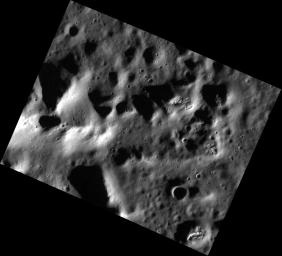
|
I Just Can’t Get Enough!
- Click the image above for a larger view
- Full-Res JPEG (1620 x 1471) (188.2 kB)
- Full-Res TIFF (1620 x 1471) (2.4 MB)
Caption:
The image above shows a section of the central peak of Verdi , which has been altered by (you guessed it!) hollows . Some hollows seem to form preferentially on central peaks, indicating that their formation may be related to instabilities in material that originally resided at a greater depth. Central peaks host some of the deepest material brought up by impact events and can tell us a lot about what lies beneath the surface.
This image was acquired as a high-resolution targeted observation. Targeted observations are images of a small area on Mercury's surface at resolutions much higher than the 200-meter/pixel morphology base map. It is not possible to cover all of Mercury's surface at this high resolution, but typically several areas of high scientific interest are imaged in this mode each week.
Date acquired:
April 06, 2013
Image Mission Elapsed Time (MET):
7560284
Image ID:
3831344
Instrument:
Narrow Angle Camera (NAC) of the Mercury Dual Imaging System (MDIS)
Center Latitude:
64.49°
Center Longitude:
191.0° E
Resolution:
16 meters/pixel
Scale:
This image is 21 km (13 mi.) across.
Incidence Angle:
79.4°
Emission Angle:
38.3°
Phase Angle:
117.7°
Background Info:
The MESSENGER spacecraft is the first ever to orbit the planet Mercury, and the spacecraft's seven scientific instruments and radio science investigation are unraveling the history and evolution of the Solar System's innermost planet. MESSENGER acquired over 150,000 images and extensive other data sets. MESSENGER is capable of continuing orbital operations until early 2015.
For information regarding the use of images, see the MESSENGER image use policy .
Cataloging Keywords:
| Name | Value | Additional Values |
|---|---|---|
| Target | Mercury | |
| System | ||
| Target Type | Planet | |
| Mission | MESSENGER | |
| Instrument Host | MESSENGER | |
| Host Type | Orbiter | |
| Instrument | Mercury Dual Imaging System (MDIS) | |
| Detector | Narrow Angle Camera (NAC) | |
| Extra Keywords | Grayscale, Impact, Map, Radio | |
| Acquisition Date | ||
| Release Date | 2013-05-23 | |
| Date in Caption | 2013-04-06 | |
| Image Credit | NASA/Johns Hopkins University Applied Physics Laboratory/Carnegie Institution of Washington | |
| Source | photojournal.jpl.nasa.gov/catalog/PIA17221 | |
| Identifier | PIA17221 | |
